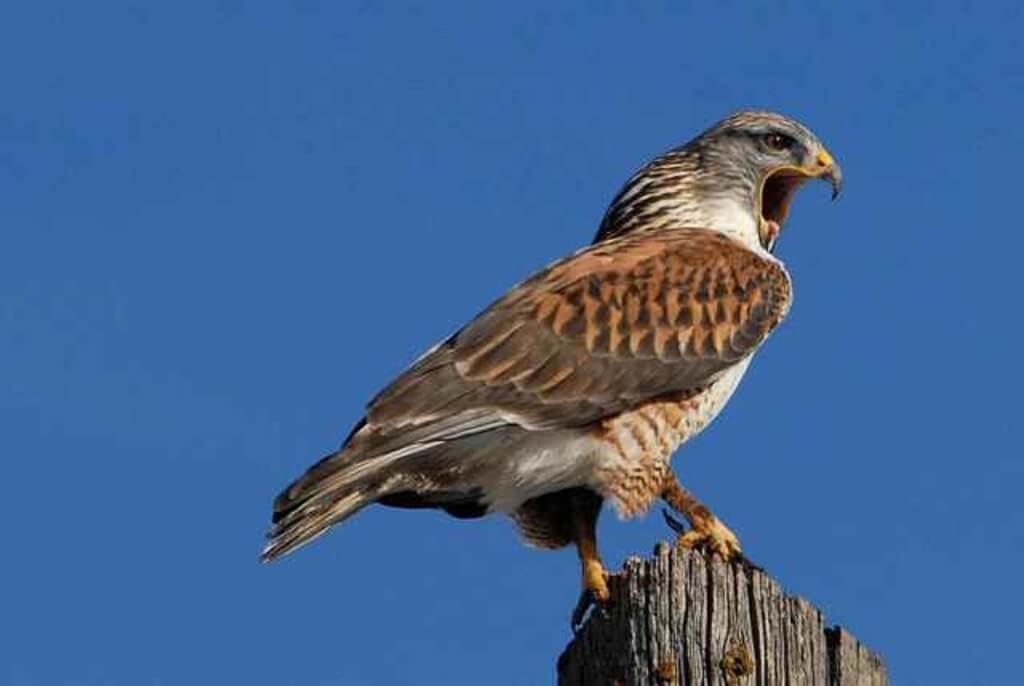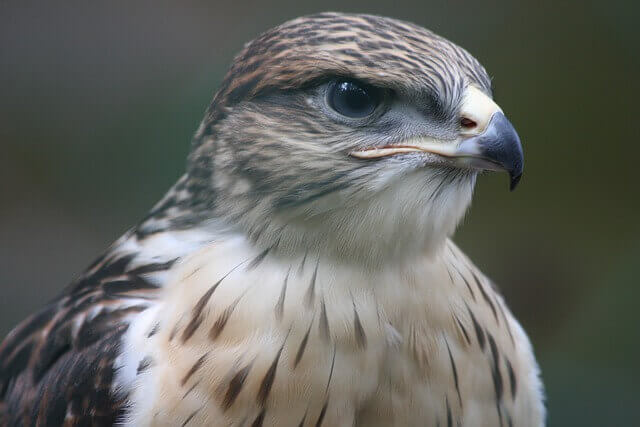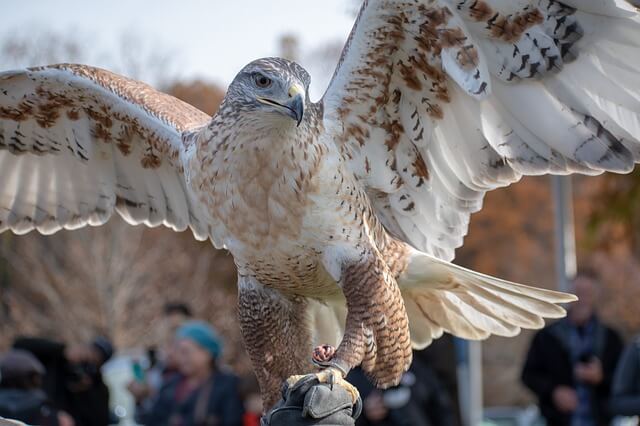In the vast expanse of the bird kingdom, few creatures command attention quite like the Ferruginous Hawk. With its imposing stature and formidable presence, this magnificent raptor captivates the hearts and minds of bird enthusiasts worldwide.
Join us on a journey through the skies as we uncover 57 intriguing Facts About The Ferruginous Hawk. From its remarkable hunting prowess to its intricate social behaviors, prepare to be enthralled by the secrets of this majestic avian marvel.
Table of Contents
Ferruginous Hawk Interesting Facts
| Characteristics | Description |
|---|---|
| Identification | There are two color forms: Light morph individuals have a light gray head, cheeks, neck, breast, and belly, with a chestnut-colored back, shoulders, wings, and V-shaped leggings. They also have some chestnut-colored spots under the wing. Dark morph individuals have a darker plumage throughout. |
| Length | 22.1-27.2 inches (56-69 cm). |
| Weight | 34.5-73.2 ounces (977-2074 g). |
| Wingspan | 52.4-55.9 inches (133-142 cm). |
| Taxonomy | Kingdom: Animalia, Phylum: Chordata, Class: Aves, Order: Accipitriformes, Family: Accipitridae, Genus: Buteo, Species: B. regalis, Binomial Name: Buteo regalis (George Robert Gray: 1844), Scientific Name: Buteo regalis. |
| Range | The Ferruginous Hawk lives throughout the Western United States (eastern Washington north to southern Alberta, southern Saskatchewan and Manitoba; east to the Dakotas, Nebraska, Kansas, Oklahoma, and Texas; south to New Mexico and Arizona; and west to California and Oregon) and Southwestern Canada, with its range extending south into Northern Mexico. The largest populations are found on the Great Plains region of central North America. |
| Fall Migration | September through to October: This species migrates south to Central America for winter, where it lives in humid rainforests or dense dry forests near water sources. |
| Spring Migration | Late March through early April: They usually head back north. |
| Habitat | They live mostly in open country with low vegetation such as prairies, grasslands, scrublands, or deserts where they can hunt for small mammals like rabbits and mice that form their diet. |
| Diet | Their diet consists mainly of small mammals such as rodents, ground squirrels, and rabbits; they also eat lizards, snakes, insects, and birds (particularly nestlings). |
| Global Extent of Occurrence | 4,330,000 km2 (1,671,822.346 sq mi). |
| Global Breeding Population | Estimated 80,000. |
| Conservation Status | Listed as Least Concern (Population is increasing). |
| Lifespan | In the Wild: Between 8–23 years of age; In Captivity: Over 30 years of age. |
| Breeding Period | March through April. |
| Incubation Duration | 32–33 days. |
| Nestling Duration | 38–50 days. |
| Chicks Fledge | 45–50 days. |
| Clutch Size | 2–8 eggs. |
| Egg Color | Buff with brown spots. |
| Nesting Habits | Ferruginous Hawks nest in various locations, including forests, cliffs, and man-made structures like utility buildings. They construct nests using materials like twigs and sticks. The female lays two to eight eggs, and both parents take turns incubating them for about 40 days. After hatching, the parents care for the chicks, which fledge and become independent after about 45–50 days, staying on their parents’ territory for up to two months. |
- Physical Size: The Ferruginous Hawk (Buteo regalis) is one of the largest and heaviest hawks native to North America, with a wingspan ranging from 4.5 to 5 feet.
- Habitat Range: These hawks can be found in a diverse range of habitats, including grasslands, deserts, shrublands, and open country.
- Distribution: Their range extends across North America, from Alaska and Canada to parts of the United States, including Arizona, Montana, and New Mexico.
- Sexual Dimorphism: Ferruginous Hawks exhibit sexual dimorphism, with females being larger than males. Female hawks typically have a wingspan of around 5 feet.
- Breeding Range: In Canada, they breed from British Columbia to Labrador and Alaska, extending to Quebec, covering around 10% of their global breeding distribution.
- Longevity: The oldest known Ferruginous Hawk, discovered in Nevada in 2006, lived to be almost 24 years old.
- Monogamous Mates: Ferruginous Hawks are monogamous and typically mate for life. They form strong, long-lasting pair bonds, with both partners involved in raising their young.
- Hunting Roles: During the breeding season, male hawks take on the primary responsibility of hunting for food, while the female guards the nest and feeds the chicks.
- Sensory Abilities: Like all members of the Accipitridae family, they possess excellent hearing and can detect sounds at points of high activity, aiding in locating prey and hunting more effectively.
- Keen Eyesight: Ferruginous Hawks have exceptional eyesight, enabling them to spot prey from considerable distances—up to 1 mile away.
- Diet Variety: Their diet primarily consists of small mammals, including rodents like ground squirrels, prairie dogs, and rabbits. They also consume lizards, snakes, insects, and occasionally birds.
- Nesting Preferences: These hawks often choose existing nests, such as those built by crows or other hawks, as nesting sites. They may also use various structures, including cliffs, trees, utility structures, and even abandoned farm machinery.
- Nest Materials: Nests are constructed using a mix of materials such as twigs, sagebrush stems, plastic, scrap metal, sticks, and sometimes even bison bones and dung.
- Nest Size: The average Ferruginous Hawk nest measures approximately three feet across by three feet high.
- Clutch Size: Females typically lay two to eight eggs per clutch, and incubation is shared by both males and females, lasting about 40 days.
- Hatchlings: When hatchlings emerge, they are weak, covered in down, and have their eyes closed. The female initially stays with them, while the male hunts and provides food.
- Fledging: At around 38 days old, the young hawks start exploring the surroundings by hopping from branch to branch. They begin flying between 45 to 50 days of age.
- Parental Care: Chicks may stay on their parents’ territory for up to two months until they become self-dependent.
- Winter Migration: During the winter, Ferruginous Hawks migrate to warmer regions in Central America, where they inhabit humid rainforests and dense dry forests near water sources.
- Spring Migration: They return to their breeding grounds in North America during late March through early April, marking the onset of the breeding season.
- Habitat Diversity: Their adaptability to various habitats allows them to thrive in environments ranging from grassy plains to desert regions.
- Conservation Status: As of current assessments, Ferruginous Hawks are classified as “Least Concern” on the conservation scale, with their population showing signs of growth.
- Lifespan: In the wild, Ferruginous Hawks typically live between 8 to 23 years, while those in captivity can exceed 30 years of age.
- Territorial Behavior: These hawks are known for their territorial nature, defending their nesting sites and hunting grounds from intruders.
- Threats: While not currently at high risk, potential threats include habitat loss, human disturbance, and the use of rodenticides, which can harm their primary prey species.
- Research and Conservation: Ongoing research and conservation efforts are crucial for understanding and safeguarding Ferruginous Hawks and their ecosystems.
- Physical Size: The Ferruginous Hawk, scientifically known as Buteo regalis, stands out as one of the largest and heaviest hawks native to North America. With a wingspan spanning from 4.5 to 5 feet, they possess an impressive physical presence in the avian world.
- Habitat Range: These hawks exhibit remarkable adaptability, thriving in diverse habitats. They can be found across a wide range, from arid deserts and grasslands to shrublands and open plains, showcasing their ability to exploit various ecological niches.
- Distribution: Ferruginous Hawks have a broad distribution spanning North America. Their range extends from Alaska and Canada, where they breed, to the southwestern United States, including Arizona, Montana, and New Mexico. This expansive distribution reflects their resilience to different environmental conditions.
- Sexual Dimorphism: This species showcases sexual dimorphism, where females are notably larger than males. Female Ferruginous Hawks, with wingspans of approximately 5 feet, exemplify this distinction and play a crucial role in breeding and parenting.
- Speed: In the realm of avian speed, Ferruginous Hawks stand out. Their horizontal flight speed ranges between 20 and 40 mph, demonstrating their efficiency in cruising low over their vast territories. When plunging to capture prey, they can attain breathtaking speeds of up to 150 mph.
- Plumage: Adult Ferruginous Hawks boast striking plumage. Their rust-colored feathers adorn the head, back, and legs, creating a captivating contrast with their pale, streaked undersides. This unique plumage aids in camouflage during their predominantly terrestrial hunting style.
- Breeding Range: Ferruginous Hawks’ breeding range is extensive, covering approximately 10% of their global distribution. In Canada, they breed from British Columbia to Labrador and from Alaska eastward to Quebec, signifying their resilience in northern climates.
- Maturity: The age of sexual maturity in Ferruginous Hawks typically occurs around 2 years, marking their transition into the reproductive phase of their lives.
- Longevity: Remarkably, the oldest recorded Ferruginous Hawk, discovered in Nevada in 2006, nearly reached its 24th year. This longevity underscores the importance of long-term ecological studies to monitor these raptors.
- Name Origin: The name “ferruginous” draws its origins from the Latin word “ferrugo,” meaning “rust.” This nomenclature aptly describes the hawk’s plumage, which exhibits rich rust-colored feathers.
- Monogamous Mates: Ferruginous Hawks are celebrated for their monogamous behavior. They form lifelong pair bonds, displaying an extraordinary commitment to their mates. This monogamy enhances the chances of successful breeding and chick rearing.
- Hunting Roles: During the breeding season, these hawks adopt specific roles in hunting and parenting. The males shoulder the primary responsibility of hunting, securing food for their growing families, while the females guard the nest and nourish the nestlings.
- Sensory Abilities: Their keen hearing, a hallmark of the Accipitridae family, is instrumental in pinpointing the movements of small mammals like rodents. This auditory acuity enables them to execute swift and effective hunting strategies.
- Keen Eyesight: Ferruginous Hawks possess exceptional vision, with the capability to spot potential prey from extensive distances, sometimes up to 1 mile away. This visual acumen aids in both locating and pursuing quarry.
- Diet Variety: Their dietary preferences primarily consist of small mammals, emphasizing the ecological role they play in controlling rodent populations. Beyond rodents, their diet encompasses lizards, snakes, insects, and occasionally birds and nestlings when opportunities arise.
- Nesting Preferences: Ferruginous Hawks exhibit diverse nesting preferences, utilizing a range of structures. They may choose existing nests, including those built by crows or other hawks, or opt for natural structures such as cliffs, trees, utility installations, abandoned farm machinery, and even haystacks.
- Nest Materials: The composition of their nests is a testament to their resourcefulness. They incorporate materials like twigs, sagebrush stems, plastic, scrap metal, sticks, and occasionally unconventional items such as bison bones and dung.
- Nest Size: Ferruginous Hawk nests, constructed with a combination of these materials, typically measure around three feet in diameter and height, offering ample space for rearing their young.
- Clutch Size: Female hawks typically lay two to eight eggs per clutch. Both males and females participate in the incubation process, sharing this duty for approximately 40 days before the eggs hatch.
- Hatchlings: Upon hatching, Ferruginous Hawk chicks are remarkably vulnerable, weak, and covered in down. Their eyes remain closed during the early stages, and the female remains attentive, providing nourishment while the male forages for food.
- Fledging: The transition to flight occurs around 45 to 50 days after hatching. Chicks initially explore their surroundings by hopping from branch to branch, gradually gaining the strength and skills required for sustained flight.
- Parental Care: Both parents actively engage in nurturing and protecting their offspring. After a few weeks, when the young hawks become more self-reliant, both parents recommence hunting to sustain their growing family.
- Territorial Attachment: Ferruginous Hawk chicks remain within their parents’ territory for up to two months. This extended period of familial association contributes to their learning and development.
- Ecosystem Role: As apex predators, Ferruginous Hawks play a vital role in maintaining ecological balance by regulating rodent populations. Their presence aids in reducing crop damage and controlling pest species.
- Conservation Concerns: While classified as “Least Concern” by the International Union for Conservation of Nature (IUCN) due to increasing populations, ongoing habitat loss, collisions with vehicles, and exposure to rodenticides are pressing conservation concerns that require attention.
- Research Opportunities: Scientific research into the ecology and behavior of Ferruginous Hawks remains critical for the development of targeted conservation strategies. This research informs our understanding of their habitat requirements and population dynamics.
- Migratory Patterns: Ferruginous Hawks exhibit seasonal migrations. They migrate south to Central America during the fall months, seeking warmer climates. This migration is triggered by the decreasing temperatures in their northern habitats.
- Spring Return: With the onset of spring, these hawks embark on their northward journey, returning to their breeding grounds. This cyclical migration reflects their innate navigation abilities and the importance of these habitats for breeding.
- Human Impact: Human activities, such as habitat alteration, urbanization, and agriculture, significantly affect Ferruginous Hawk populations. Sustainable land management practices are essential to mitigate these impacts.
- Rodenticide Risks: The use of rodenticides poses a significant threat to Ferruginous Hawks, as they can inadvertently ingest poisoned prey. Monitoring and minimizing the use of these chemicals are vital steps in safeguarding their populations and the health of their ecosystems.
Frequently Asked Questions
Are ferruginous hawks rare?
Ferruginous Hawks are rare. This is not because they are hard to find, but rather because of their low population density. They have a relatively small range, so there are fewer opportunities for them to be seen by people.
What eats ferruginous hawks?
Golden eagles are not the only predators of ferruginous hawks. There are at least five different types of animals that also prey on ferruginous hawks: great horned owls, red-tailed hawks, coyotes, kit foxes and badgers. The most significant findings in this study were that kit foxes kill the most number of ferruginous hawks.
What’s the largest hawk in Texas?
The Ferruginous Hawk is the largest hawk in Texas. It can grow up to 2 feet tall, with a wingspan of 4.5 feet wide, and a weight of 4 pounds. This species of hawk lives mainly in desert habitats, and can be found in southern parts of the United States all the way to northern Mexico.
Are ferruginous hawks carnivores?
Ferruginous hawks are carnivores. They eat rodents, snakes, birds and other small animals that they can catch on the ground or in the air. Ferruginous hawks also eat carrion (dead animals).
What is the most powerful hawk in the world?
The ferruginous hawk is the most powerful bird of prey in North America. This predator is so fierce that it’s able to hunt animals such as rabbits, squirrels, and other birds up to four times its size. The ferruginous hawk also has talons that are almost three inches long and sharp enough to pierce through flesh or bone with ease.




